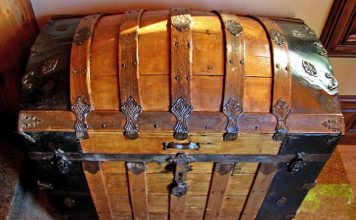By Michael Hackleman
Solar-powered pumps have proved their worth for many installations worldwide, anywhere under the sun. However, in the northern hemisphere, a year-around spring located at the base of a north-facing slope presents special challenges if it is to be pumped with the energy of the sun. Here’s a lofty solution with a down-to-earth price.
The existing system
The Jergenson brothersRichard, Phil, and Kentinstalled a good design of water system for their land at Summit, outside of Willits, California. A small solar-powered pump delivers water from a spring to several tanks located at the highest point on their land. From there, the water is delivered and pressurized energy-free anywhere on the property.
One challenge of this system has been sufficient access to solar energy. Initially, two solar panels mounted on a homebuilt cart could be positioned in a tiny meadow to catch a generous portion of the summer sun and ensure full tanks. At that time, the biggest use for the water was irrigation of a new orchard. Seasonally, the pump was disconnected and the water line drained for the winter months.
 The original installation two modules on a homemade cart to power a pump in the spring tank |
As dwellings and humans have appeared on the land, naturally the water demand has gone up. The system’s bottleneck was immediately apparent. More panels would help the summer effort but do nothing in the shadow of the mountain immediately to the south during winter months. The panels would need to be relocated. It was at this point that I was asked to help find a solution.
I reviewed the system’s initial design. Two ARCO M-75 modules were directly connected to the 24V SlowFlo pump with an adequate gauge of wire for its length.
Site considerations
The spring-fed tank is located with a forested slope rising to the south. Northward is a small meadow beyond which the slope drops off steeply. In the meadow, the solar array had easily found much of the summer sun.
At first, I looked for a new solar site in any direction. There are several types of electronic gizmos that can step the output voltage of a solar, wind, or hydro system to higher values to cover fairly long distances. Unfortunately, no site was available in any direction for six hundred feet or more that would find the winter sun most of the day.
Fortunately, I was onsite at the winter solstice. When the clouds unrolled for a few moments. I was able to see the light of the winter sun hitting the tops of the 30-foot trees at the northern edge of the meadow only 70 feet from the pump. In fact, the shadow of the mountain top was clearly etched across the trees far to the east and west. Before, the trees both upslope and downslope had made it impossible to observe the sun’s angle or the contour of the mountain directly.
The design solution
It was immediately clear to me that a 40-foot tower would put the PV modules into unobstructed sunlight for as much as 6 hours in winter. Further investigation revealed that this position would also place the modules above trees to the east and west that had previously prevented full use of the sun’s energy on summer days.
 A diagram of the tower-raising setup ensures that everyone is working on the same page. (Click picture for full-size version) |
Guyed and free-standing towers were both considered. A guyed tower depends on three or more wire sets secured to anchors spaced around and away from the tower to keep it upright. Freestanding towers depend on a wide spacing of the legs at the bottom and well-designed concrete footings.
This application favored a guyed tower. Wind-machine weight loads a tower to a much higher degree than a few solar panels. In use, a windmachine’s blades transfer big loads to a tower, while solar panels don’t. Tilted panels, particularly in summer, shed even more wind loading. Four guy wires (1/8-inch) would easily handle these loads beyond 100 mph of windspeed. All four wires had a dual role. They were positioned to also help safely raise and lower the tower.
While a tower design would address most of the challenges in pumping water through the year, I also recommended to the Jergensons the addition to the system of a LCB (linear current booster) designed for this pump. This works as an electronic “transmission,” helping with an earlier morning pump startup and partly cloudy skies throughout the day. This feature is essential in the weaker sun of winter.
 Phil, Kent, and Richard Jorgenson test the tower’s rigging at the Lift and Bounce point. |
Tracking the sun will also increase PV output. While daily (east-west) tracking was considered too expensive a solution for this installation, seasonal tracking (collector tilt) was added. The rack for the twin modules was attached to the top of the tower through a pivot bolt aligned perpendicular to the north-south line. A continuous cable (marine-type rudder) system from the array to a lever at the base of the tower was designed to permit a change in the tilt of the array, locking at virtually any angle. This allowed the Jergensons to align the PV array with the sun anywhere in its 46 degrees shift throughout the year.
Building the tower
I selected the tower material from a “parts pile” out at Summit. Several long sections of Telspar had already caught my eye. Telspar is square box tubing made of galvanized steel that’s punched with holes throughout its length on all four sides. This makes it lightweight and helps mount hardware without drilling or welding. Different sizes of Telspar telescope snugly inside of one another. I joined two long 2-inch square Telspar sections (one 20-foot long, the other 14-foot long) by bolting each to a 6-foot long 1 ¾-inch square section inserted inside and spanning the joint. The result was a tall, strong, lightweight tower.
Telspar sections, along with other hardware, were transported to the meadow. I assembled the main tower sections on the ground, using tree rounds to elevate the work to a comfortable level. At what would be the upper end of the tower, I slipped an 8-foot length of 1¾-inch square Telspar into the main section to act as a tower stub. To this I bolted the pivoting framework that would hold the two modules.
While most of this project was a solo meditation, Kent’s son, Colby, wanted to be involved. I put him to work designing foot pegs. With the tilt mechanism controlled from the tower base, there was no need to climb the tower in normal use. Still, the tower was strong enough to handle the weight of a person, and the lure of all those pre-drilled holes was strong for maintenance work. Colby came up with a good scheme for staggering and spacing the foot pegs with the materials at hand. Bolts were used with big flat washers and lengths of plastic pipe to make the pegs (see photo).
 Foot pegs facilitate toer climbing. UV-rated electrical cable is cable-tied to the tower. Inset: An LCB mounted at the tower’s base assists the pump in early morning startup or in winter sun. |
Meanwhile, I worked out where and how to attach the guy wires, both to raise the tower and safely hold it in position once it was vertical. I opted to attach two sets of four guy wires to the tower, one set at the top and the other midway up. (I traditionally add guy wire sets in multiples of 20 feet; a 40-foot tower needs two sets, a 60-foot tower needs three sets, etc.). Guy wires were attached to the tower via thimbles pushed through eyebolts. Thimbles prevent crimping and weakening of the wires, allowing them to be safely doubled back and clamped. The process was repeated at the anchors with turnbuckles added to change the tension on the wires.
An array-tilting feature was added. I choose a variation of the continuous wire system (like that used to control the rudder of many boats) for this function. This keeps the array rigid through tension but easy to adjust when desired. Simple experimentation located the right attachment points at each end so that the lever kept both wires tensioned uniformly through tilt changes. I used small pulley wheels to route the wire through angle changes. The modules were bolted to the rack, electrical cable was wired from the pump to the collectors (the pump worked!), and the tilting mechanism system was tested and tuned.
Rigging the tower
Tower raising is 95% preparation and perspiration and 5% actual raising. Since I wanted the Jergensons to be familiar with raising the towera most helpful exercise when the day comes to lower itI waited to finish the rigging until I could get everyone together on the day we planned to raise it.
I figured out a way to raise this tower long before I started building it. The solutions may at first evade me but I know the right questions to ask. (I devoted the biggest chapter in an earlier book, The Homebuilt Wind Generated Electricity Handbook, to the subject of tower raising.) There are as many variations on the way to do this as there are towers to raise. Large objects (rocks, trees, and buildings), icky spots (mudflats and streambeds), and non-solid areas (ravines and ponds) will dictate what you cannot do. Uneven terrain will complicate the setup somewhat. Rigging a tower for a raise is a three-dimensional experience. Paper is two dimensional, containing side and top and, at best, isometric views. I sketched out a plan and included notes that I could revisit and revise as needed.
The challenges of this installation were clear. The site had poor vehicle access, yet we had no winch. We wanted to use a vehicle to pull a cable and raise the tower, but we would have no direct raise angle. That is, the best way to lay the tower and raise it was not in alignment with the way the vehicle could move.
The solution was to thread the raising cable through a pulley that was positioned at the junction of two imaginary lines representing the tower’s alignment and the vehicle’s direction of travel. A length of climbing rope was used to secure this pulley to a tree that would effectively bisect these two angles (see drawing). This sounds complicated but it really isn’t. Realize that the tension in the raising cable is equal on both the tower and vehicle side of the COA (change of angle) pulley. Connect the raising cable through the pulley to the tower and vehicle bumper and tension it slightly. Now, adjust the length of rope holding the COA pulley to its anchor (in this case, a tree) until the raising cable on the tower side is aligned with the tower’s axis. As long as the truck moves along the same axis it makes with the raising cable, the COA pulley will stay in position during the tower’s raise.
I’ve used wires and cables interchangeably so farbecause they are. I selected twisted wire cables available from hardware stores for all guy wires that would hold the tower erect. In our salt-free environment, galvanized wire supplies good weatherability. Harsher environments may dictate stainless steel (aircraft) cable.
Guy wires perpendicular to the raising axis (side wires) are easiest to rig. Simply connect one end to the tower on each sideone midway, one near the topand the other to their anchor. In theory, their length on the ground is equal to their length raised. Unequal ground will throw this off somewhat, so compensate or leave an extra 10% to their length for later adjustment. A benefit of this geometry is that these wires will maintain a tension throughout the raise, protecting the tower from swinging or falling to either side.
I located all four anchors equidistant around the tower and 30 feet away. (Locate anchors not less than half the distance away as the tower is high.)
 The 42-foot tall tower is slender but is easily climbed to clean the modules and inspect the hardware and wires. (Always wear a tower belt!) |
Since I could not go beyond 30 feet in the western direction, I held the remaining anchors to this distance to simplify the geometry. Thus, I was able to cut and affix both the back-support wire set and the front-support wire set on the ground by merely duplicating the lengths of the side wire sets. (Back-support wires prevent endover during raise. Front support wires permit the removal of the raising cable once the tower is vertical.)
A l0-foot long section of Telspar was bolted perpendicular to the base of the tower to act as a gin pole. A gin pole’s job is to give a lift angle to the raising cable, decreasing the initial tension (pounds of pull) on the raising cable before the tower starts to lift. A shorter length of Telspar was bolted perpendicular to both tower and gin pole at their intersection. For this size of tubing, it created a tri-joint, locking everything solid at 90 degrees.
I used one long length of 3/8-inch steel cable for two functions: anti-slip and raising cable. Even with a tall gin pole, most of the initial tension of the raising cable wants to pull the bottom of the tower in the direction of the pull. Securing a cable between the bottom of the tower and the anchor for the backsupport wires prevents this slippage. The remainder of the steel cable was looped around and clamped to the top of the tower, threaded through a pulley at the top of the gin pole, threaded through the COA pulley, and looped around and clamped to the truck’s bumper. Rope can be substituted for these jobs if it and the block & tackle hardware are sized for the load.
Raising the tower
A good tower raising is one that can be stopped, even reversed, at any point. Accordingly, it takes the worry out of getting everything right the first time, especially if there’s a crowd. Actually, there were only four people present at this raisePhil, Richard and Kent Jergenson, and myself. Once the rigging was complete, we had our pre-raise meeting. Herein, we discussed the different steps of the raising process, what to watch for, what to do, what not to do, etc. I assigned Phil and Richard to the side guy wire anchors, with escape routes identified. Kent would handle the truck. I positioned myself near the COA pulley and aligned with the tower. We were ready.
I established five stop points during the raise. Pre-lift. Lift and bounce. Gin pole pre-clear. Pre-vertical. Vertical. Of course, the raise can be stopped if anything gets too light or if something unexpected happens. (Do I need to mention that you should discourage all participants from running amuck within the area of the tower’s reach? Solar panels and towers are expendable, lives are not.)
Pre-lift
I signalled to start edging the truck backward, tensioning the raising cable until the tower just started to lift. I yelled and signalled stop. We inspected cables for slippage and tautness, and any slippage of the tower base. Everything checked okay.
Lift and bounce
I signalled to pull until the tower top was about two feet clear of its tree round and stopped. The greatest stress on the tower, cable, and cable connections in the raising of a tower is the moment of liftoff, when the cable tension is the greatest. If you can’t make it break or slip here, it’s unlikely to thereafter. (After 51 tower raisings, it hasn’t yet.) I sat on the tower top. It sagged down but held. I bounced. It bounced.
Gin pole pre-clear
The raising continued until the cable was ready to clear (rise away from) the gin-pole. Stopping here permits two important inspections. First, will the method to re-position the raising cable over the gin pole work if the tower must be lowered? Second, how is the tension in the side guy wires? One side-guy wire can be taut while the other is slack. This is normal, suggesting only that the tower is being pulled to one side or the other by a slight misalignment of the raising cable. An adjustment in the position of the COA pulley may be needed if the tension is too high on one side. In no case should guy wires on both sides of the tower be tight simultaneously. This suggests an error in guy wire lengths. Correct this condition by loosening the guy wires on the side that allows the tower to find its center.
Pre-vertical
The raising was continued until the tower was at an angle about 15 degrees short of vertical. Here the back-support cables are checked to ensure they will keep the tower from following the raising cable too far past the vertical point.
Vertical
The tower was brought vertical. Actually, the weight of the raising cable was enough to bring the tower upright the last 10 degrees, balancing the tension in the back-support cables. The front-support cables were attached to their anchor so the raising cable could be disconnected. A bubble level was used to confirm that the tower was vertical and guy wires loosened or tensioned until uniform.
Post-raise
The raising took about 10 minutes from start to finish. We toasted the event with a beer before taking photos. Post-raise rigging took another 45 minutes. The solar panels were rotated to the correct tilt. I climbed the tower, releasing the raising cable and
enjoying the view. I couldn’t coax anyone into climbing the tower. I think its light weight and the slenderness of the tower and guy wires gives the impression of flimsiness to the
casual observer.
 After the raise, I asked Kent and Richard if they were happy and this was their response. |
Climbing or working on a tower looks easy just watching but is difficult for the average person to attempt, much less feel comfortable doing. Time helps. I remember how shaky the tower felt the first few times I climbed on one. As with bicycles and skateboards, one’s own nervousness contributes to the shaking. Take your time, rest, look around. Use a tower belt. Climb to a point where you feel comfortable, hook up the tower belt, and let it do the job of holding you there, hands free. Move slowly, attaching and detaching methodically. I figure it’s as close to a spacewalk as I’m likely to get, so I revel in it.
Nine months later
The spring site and tower are presently unreachable by vehicle during winter months. As spring approached, I walked in with a friend to check things over. Record-setting winds and gusts during the winter had me feeling a little apprehensive. When we reached the clearing, we found everything as we had left it. The pump was running. When I tried to change the angle of the panels, I found the angle-changing mechanism to be jammed. I climbed the tower to find that the cable had jumped off its guides. This I quickly remedied. This summer, the tower will get concrete reinforced guy stations and a concrete base. We won’t have to lower the tower to do this.
Altogether, this project was simple, inexpensive, and highly successful. The Jergensons were amazed at how little material, money, time, and effort went into this project. I encourage anyone buried in the trees or stuck on the wrong side of the hill to consider a similar solution to bring the power of sunlight to any worthwhile application.
(Tower raising is one whole chapter in The Homebuilt Wind-Generated Electricity Handbook, (Peace Press, 1975, 194pp) and is available for $10 from Michael Hackleman, POB 327, Willits, CA 95490. Or email: mhackleman@saber.net)














